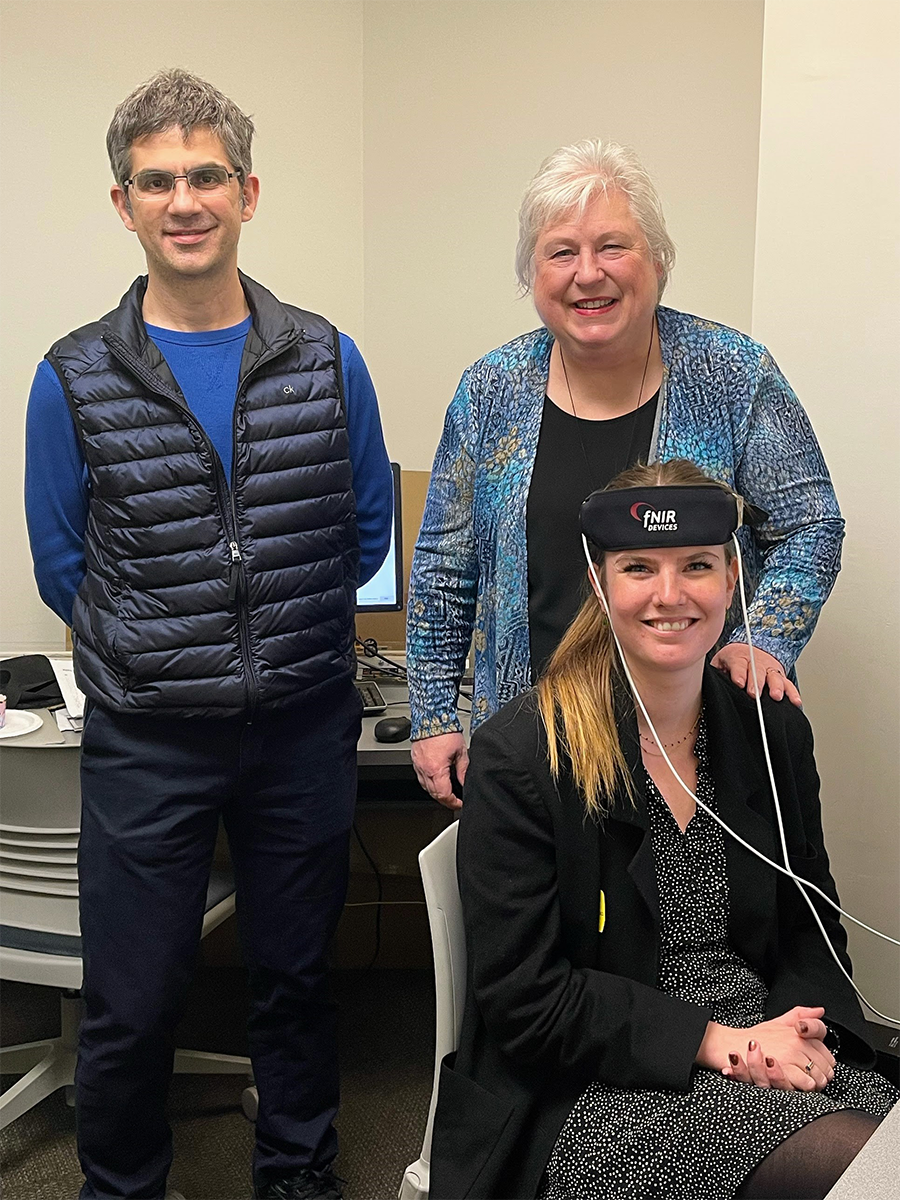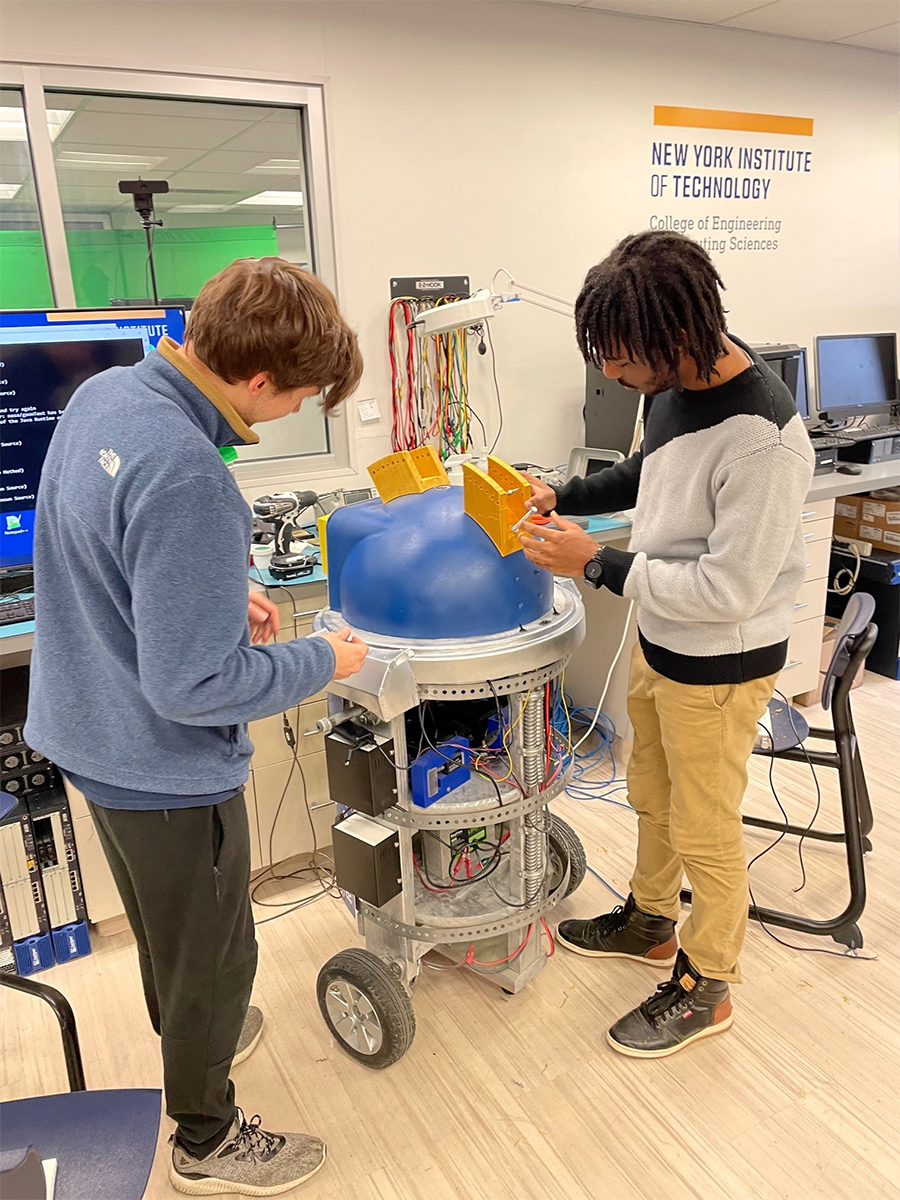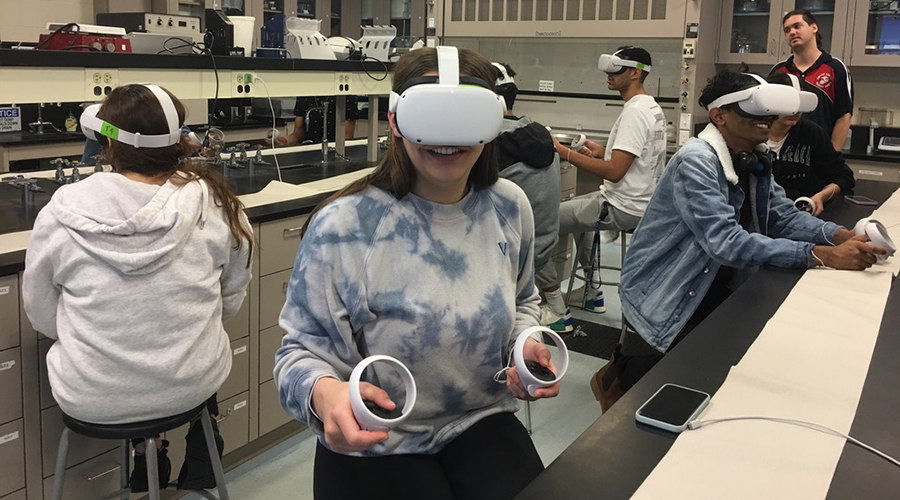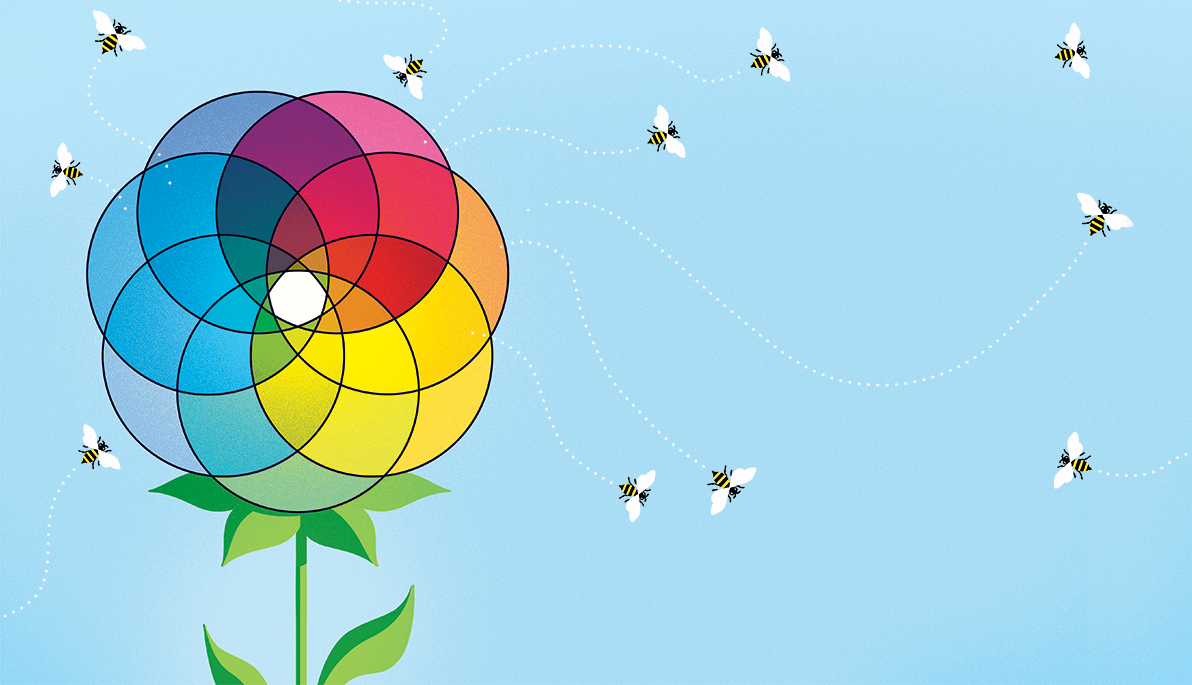News
Research for a Better World
December 5, 2022
New York Tech faculty and students who want to dream big are finding exciting new opportunities to work with like-minded individuals outside their own departments and disciplines—opportunities that encourage inclusion to explore new ideas, techniques, and insights that are propelling the university’s research enterprise forward and finding solutions to critical real-world issues.
“Cross-disciplinary pollination of projects adds layers of information that can only be acquired when working with people from different areas, backgrounds, cultures, and interests,” notes N. Sertac Artan, Ph.D., associate professor of electrical and computer engineering, who is currently working on a research project with Colleen Kirk, D.P.S., associate professor of management and marketing studies.
The unlikely pair is among three groups of faculty and students—graduate and undergraduate alike—who are working together on entrepreneurial and interdisciplinary projects, including exploring virtual reality (VR) and 3-D to enhance learning, robotic assistance to address staff shortages in healthcare, and neuromarketing to assess consumer behavior.
Exploring Neuromarketing
 Graduate student Lisbeth Sandoe Pedersen wears a fNIRS headband, which is used to measure brain activity to learn how and when consumers get territorial. Pictured here with Professors Artan (left) and Kirk.
Graduate student Lisbeth Sandoe Pedersen wears a fNIRS headband, which is used to measure brain activity to learn how and when consumers get territorial. Pictured here with Professors Artan (left) and Kirk.Artan and Kirk’s joint project explores consumers’ psychological ownership (when shoppers feel ownership of something before they buy it) and their territorial responses. In research published in the Journal of Consumer Research, Kirk and her fellow researchers have used a variety of tools and experiments to learn how and when consumers get territorial.
But while Kirk says that consumer responses to marketing stimuli are usually measured with surveys, Artan’s role added a layer of physiological information using functional near-infrared spectroscopy (fNIRS), examining if an emotional response reported by subjects coincided with a measurable physiological reaction.
Using a noninvasive headband with lights and sensors, Artan recorded changes in blood flow and oxygen concentration, an indicator of brain activity. “In this research, we are investigating whether activity in different brain regions coincides with a greater degree of feeling infringed upon or feeling territorial,” he says.
The measurement of physiological signals to gather information about customers’ preferences and choices is called neuromarketing, helping to determine whether emotions are impacting the brain or the other way around. This emerging field, which connects thoughts, behaviors, and brain function, could hold important clues for a number of disciplines.
“Marketing and psychology intersect quite a bit, especially regarding marketing strategies,” notes Lisbeth Sandoe Pedersen, a graduate student who assisted on the project. She holds dual bachelor’s degrees in communication studies and psychology and is working on a master’s in communication arts at New York Tech.
Cross-disciplinary pollination of projects adds layers of information that can only be acquired when working with people from different areas, backgrounds, cultures, and interests.
Associate Professor N. Sertac Artan, Ph.D.
“The research project will contribute to understanding different behavior types and how these individuals might respond to marketing strategies. Neuromarketing gives us an understanding at the intersection of communication, psychology, and physiology,” she says.
Given insight into this new field, Pedersen is thinking about exploring it further: “I am considering pursuing a doctorate, and being part of this project enabled me to gain experience conducting a long-term scholarly research project. Neuromarketing presents interesting opportunities. My dream is to use my degrees to consult in the nonprofit or government sector to do good and make the world better.”
“I teach students how to observe behaviors and the difference between what they think is going on and what is happening. Participating in research teaches students how to remove themselves and their inferences from the equation,” Kirk says. “Unbiased observation is a life skill that can be used no matter where students find themselves.”
Innovative Solutions to Healthcare Worker Shortages
And while the lives of students are enriched by participating in research, others can benefit as well. The collaborative effort of New York Tech medical, engineering, and computer science students, for example, may have found one solution to the lack of healthcare workers. Michael Nizich, Ph.D., director of the Entrepreneurship and Technology Innovation Center (ETIC) in the College of Engineering and Computing Sciences, and College of Osteopathic Medicine Professor of Clinical Studies Todd Cohen, M.D., and their graduate and undergraduate students recently collaborated on research to determine whether robots could perform simple routine tasks of surgical assistants.
The project investigated whether a robot could retract tissue during pacemaker implantation. The team explored if the semiautonomous ETIC Research Robot for Student Engagement and Learning Activities (E.R.R.S.E.L.A.) could be designed to navigate a surgical suite, extend a retractor, and use the necessary strength and force to maintain tissue retraction.
 Students configure original mounting brackets for a custom-designed robotic arm that will enable E.R.R.S.E.L.A. to function as a surgical assistant.
Students configure original mounting brackets for a custom-designed robotic arm that will enable E.R.R.S.E.L.A. to function as a surgical assistant.“E.R.R.S.E.L.A. was built to engage students remotely, regardless of location,” says Nizich. Built from scratch by ETIC staff and students, all the robot’s software, operating systems, and mechanical components are original, giving the team freedom to adjust as needed. “The robot gains functions yearly with different student projects,” Nizich notes.
In this project, E.R.R.S.E.L.A. needed to roll over to the operating table, extend its arm with the retractor, place the retractor precisely, and pull back the skin on a mounted rubber model.
“The engineering and medical students involved worked together to program the needed functions,” Nizich says. “The medical students learn about robotics in medicine, and the engineering students learn to refine the robot’s capabilities and programs to match the parameters put forth by the medical team.”
“I have always been interested in robotics, so to be involved in this project and gain knowledge about robotics has been amazing,” says second-year osteopathic medical student Nolberto Jaramillo.
Working with other students outside of their areas of expertise stretches the students in ways that aren’t attainable when working with those who have the same knowledge and understanding. Each student must communicate and comprehend the complexities of all aspects of the project for it to be successful.
“Osteopathic medicine isn’t always associated with computers or technology. However, as osteopaths, our mission is to restore the body to heal itself. Technology is one tool available to do just that,” Jaramillo says. “It has been a great experience working with the engineering students and Dr. Nizich. Having the opportunity to branch out and gain exposure in other areas that explore future technologies is an advantage that I wouldn’t find at other schools.”
Three-Dimensional Learning
Exposing students to innovative learning opportunities is paramount at New York Tech. A collaborative effort between Assistant Professor of Digital Art and Design Kevin Park and his UX/UI graduate students in the School of Architecture and Design; Assistant Professor of Biological and Chemical Sciences Jacqueline Keighron, Ph.D.; and Assistant Professor of Behavioral Sciences Nicole Calma-Roddin, Ph.D., in the College of Arts and Sciences, explored the use of virtual reality/augmented reality (VR/AR) technology in enhancing understanding and retention of classroom material.
Technology gives us the freedom to explore multiple avenues to learning and engagement rather than a teacher telling students this one way is how you should learn.
Assistant Professor Kevin Park
“The thought was that adapting and converting a biochemistry lesson from the lab to a 3-D environment would allow students to explore the information in a new way that isn’t possible with a textbook image or lab exercise,” Keighron says. “We wanted to study students interacting in a 3-D environment. Did this virtual experience influence their comprehension and retention? How motivated were students to engage with the content and each other in this virtual setting?”
UX/UI graduate students Lavin Amarnani, Kyle Diaz-Castro, Mohammed Irfan Shaik, and digital art and design graduate student Vaibhavi Deo designed, built, and tested the environment while emphasizing the ease of use for students and teachers. Making the overarching design adaptable to any subject, amount of information, and other projects was key. In addition, the students needed to make the experience user-friendly without the need for 3-D headsets so that a wider audience could benefit from these virtual lessons.
“The graduate students began with several platform options mimicking a classroom, then expanded to more open-ended architecture, allowing more versatility and flexibility,” notes Park. Taking the lesson, which included a 3-D model, written information, and audio, into an interactive environment was challenging for the students. They discussed everything from how and where to place the information to what could be incorporated within the lesson to encourage engagement and exploration of content.
Park pushed his UX/UI graduate students through the learning process so they could implement what they learned in a real-life situation. “With each test run of students through the virtual environment, the graduate students made adjustments, incorporated feedback, and added increasingly inventive activities that I hadn’t imagined was even possible,” Keighron says.
 Biochemistry students using VR to view and interact with 3-D structures of proteins and carbohydrates they work with in the lab.
Biochemistry students using VR to view and interact with 3-D structures of proteins and carbohydrates they work with in the lab.
“Students were able to pick up molecules, stretch them out, and step inside them thanks to the hard work and imagination of Lavin and Kevin’s other grad students,” notes Keighron. “Some students had experienced virtual reality in games, but not in a learning context,” says Amarnani. “The challenge was designing the environment to be adaptable for other projects and to be easy to use while presenting the material to make learning enjoyable.”
Avatars were able to interact with one another, sharing information and asking questions as the students navigated through rooms. In addition, the avatars could step inside molecules too small for the naked eye, toss them to one another, and participate in a scavenger hunt. The program has endless possibilities and adaptions that are only dependent on the imagination of its creators.
Presenting lessons in a virtual environment opens up an entirely new paradigm for faculty and students. Having lessons available in an interactive form to anyone, anywhere, at any time of day may change how the world views education in the future.
This technology also offers teachers a more engaging option to reach those students with learning challenges who don’t do well in a traditional classroom. “I think 3-D environments will dominate learning in the future,” says Amarnani. “Before the project, I thought I wanted to design apps and websites. Having developed an environment for virtual reality rather than a flat page, I see how this emergent technology will advance into the mainstream and touch every aspect of life. I now see myself specializing in designing these virtual reality environments.”
“The project will open up conversations with faculty and students about how best to present material,” Park says. “Technology gives us the freedom to explore multiple avenues to learning and engagement rather than a teacher telling students this one way is how you should learn.”
Research Participation Fuels Imagination and Discovers Solutions
Successfully navigating our complex world requires accurate, unbiased communication, critical thinking, incorporating feedback from others, and out-of-the-box thinking that in turn is capable of solving the most complex of problems. All these skills can be practiced in research, particularly interdisciplinary research that incorporates different perspectives and approaches.
Notes Kirk, “Fostering conversations, adding different individuals, departments, and specialties add layers of expertise, which leads to questions, possibilities, and solutions that we wouldn’t attain otherwise.”
This article originally appeared in the Fall 2022 issue of New York Institute of Technology Magazine.
By Denice Rackley




